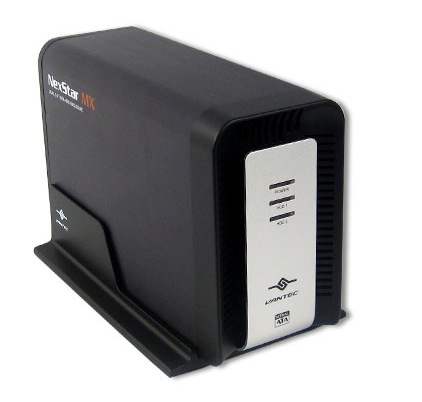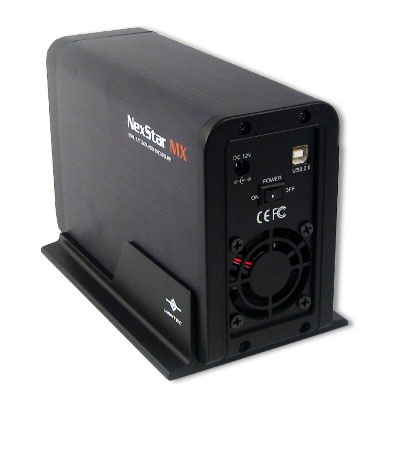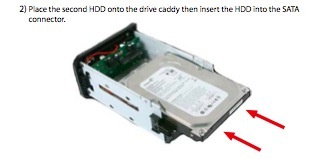Spinning discs rule – if only just.
First, a few words about large traditional spinning disk (HDD) external drive enclosures. These are still the cheapest way to store large amounts of data. The recent floods in Thailand, which accounts for one third of global drive manufacturing, have increased prices from as low as 9 cents/gB to maybe 11 cents/gB for the slower drives, but that still puts SSDs to shame, with prices around $3/gB, or 25x as much. And SSD capacities are atill low. A 1tB Western Digital Caviar Green HDD runs some $130 today.
My rule is that if you buy a single traditional HDD for storage you are playing with fire. Drives simply must be duplicated as one or the other will eventually fail. A device whose multiple platters spin at a minimum of 5,400rpm – that’s 2.84 billion revolutions a year if left on – and whose data heads fly back and forth at insane speeds, is a modern miracle which works awfully hard. So matched pairs it is. Further, I don’t buy ‘passive cooling’ arguments, where fins are claimed to conduct heat away. Nope, if it doesn’t have a fan I’m not interested. And finally, I don’t trust RAID. A simple copy works for me, not yet more technology waiting to go wrong. I use Carbon Copy Cloner for automated overnight backups so that there’s nothing to forget.
When one of my OWC/MacSales enclosures recently failed, just out of warranty (naturally), a failure that was the driver for yesterday’s column, I ordered a like replacement from OWC. These are not cheap at $120 each but they are well made, beautifully finished in unpainted aluminum and as only one of the five I have owned for years had failed I didn’t particularly want to explore alternatives. But OWC has changed the design and the latest variant which ships without drives has deleted the internal dip switches which permitted setting the box to recognize the two drives inside as individual devices. The current version permits RAID only. Back it went. OWC told me they only sell these with pre-installed HDDs of their make of choice for individual drive setups, as some makers’ drives are too temperamental to be thus recognized. I had two good drives, so an empty enclosure was what I required.
So I shopped around for a dual drive, fan cooled enclosure, which permitted the two drives to be recognized as separate devices, and settled a tad reluctantly on the Vantec NexStar MX. The low price was troubling – just $45 from Amazon USA. Further, the Amazon reviews complained about the fan noise but I reckoned at that price there was little to lose. Well, it turns out this is a fine enclosure. While it comes in black only, the drive mounting scheme is far superior to the fiddly cables used by OWC. The drives simply slide in, there are no cables, and each is retained with the screws provided. Four more small Philips screws hold the enclosure together and you are in business. The enclosure is beautifully made, requiring no excuses. This is USB2 only, so high data transfer rates will not happen here, but for mass storage of photographs or movies, these are just the ticket. The drive enclosure is 12 feet away from where I work so fan noise is not an issue. If it is you could probably hack away the grille to reduce it or reduce the fan speed as one Amazon reviewer did. He soldered a 120 ohm resistor in series with the power supply cable to the fan. The trade off is that the enclosure will run hotter.

There’s a green power light and a blue LED for each HDD to denote activity.

Rear view. The stand need not be used in practice and is removable.

The drives simply slide in. No cables required.
The manual specifically states that the capacity is 2 x 1tB HDDs. Amazon reviewers suggest that 2 x 1.5tB is possible although new drivers may have to be installed. I don’t know if this enclosure will support larger drives. I doubt it. So if you are happy with two 1tB HDDs, this is fine. Anything larger, do your research first. 2tB drives currnetly offer the lowest data storage cost per byte. I rather suspect that if you partition these into two 1tB partitions they will work fine, as I am guessing that the enclosure’s drive controller chip is choking at anything larger than a 1tB partition, but I do not know. Finally, this enclosure will not support the higher data transfer rates offered by the latest SATAIII HDDs. It supports SATAI and II only. If you can live with those limitations it’s a fine and inexpensive solution for large volume data storage needs.